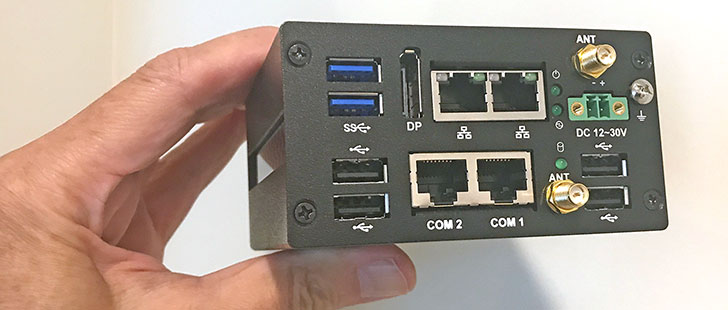|
Portwell LYNX-612G
Versatile building block: Portwell's ultra-compact fanless and cableless IoT gateway industrial PC
(by Conrad H. Blickenstorfer)
Share on:



In this article we're examining the Portwell LYNX-612G, another of a new generation of very compact industrial IoT gateway computers. What's an industrial IoT gateway? It is a small, reliable PC used to share, filter and transport data from sensors up to higher level intelligent systems and from there to the cloud.
Portwell, a Taiwanese industrial embedded systems manufacturer and solutions provider with American Portwell Technology, Inc. headquartered in Fremont, California, as its US representation, has been in the business for more than a quarter of a century. In addition to Taiwan and the U.S., the company has a presence and offices in Japan, China, the United Kingdom, Germany, and India.
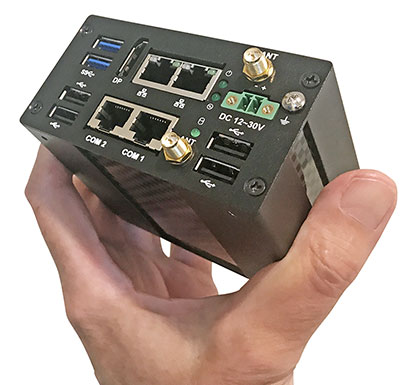
The Portwell LYNX-612G — though it is a full-fledged and full-function Windows (or Linux) PC brimming with ports — has a footprint of just 14 square inches, a good deal less than a modern smartphone.
Tightly packed
In order to fill the role of an IoT gateway, a system must not only be small enough to fit just about anywhere, it must also be rugged enough to reliably run under adverse condition, have multiple connectivity, secure remote management, use little power, but still have enough punch to get the job done.
The image below shows LYNX-612G from the top and from all four sides.
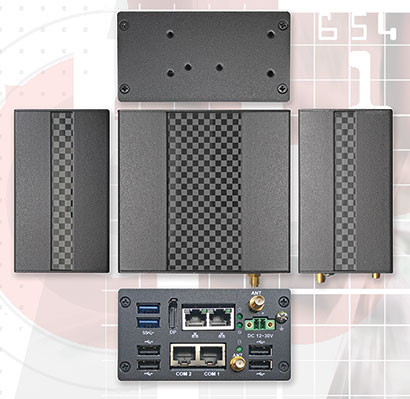
Like most industrial PCs, the LYNX is a fanless, tightly packed design of steel and aluminum. The aluminum makes up most of the housing, serving both as structure and as heat sink and heat dissipator. The front, with its port cutouts, and the back are steel. Note that Portwell uses a simple, clever way to create a custom look: acrylic inserts can be any color or any design.
Inside the super-compact housing sits an entire PC. How can you pack a whole PC with plenty of wired I/O onto a roughly 3-3/4 x 3-3/4 inch square? By building up. Yes, the LYNX 612G is a two-story affair, the functionality split between two boards, one sitting on top of the other. Below a look onto one of the two boards with its mPCIe and M.2 Key B expansion socket, one used by a 256GB solid state disk module to augment the 32GB of onboard eMMC storage.
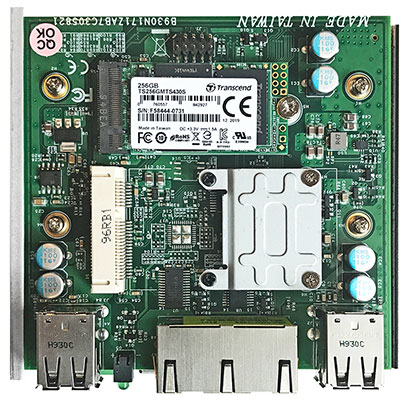
Below is a look at the front side of the LYNX, with the coverplate removed. Both boards have edge-mount I/O, with connectivity spread between the two levels. Our review unit came with an extended I/O interface configuration with four additional USB 2.0 ports and two RS232 COM ports using, probably for space reasons, the RJ45 jack format.
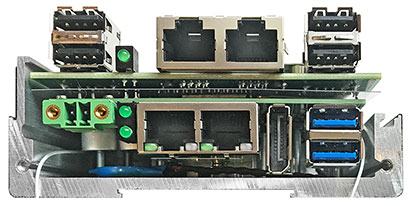
Note that Portwell offers three versions of the LYNX, the basic LYNX-6110 with a "one-story" design that's even more compact, and the two extended versions. The 612E offers two standard DP9 ports, one RS232 and one RS232/422/485.
|
Portwell
|
LYNX-6110
|
LYNX-612E
|
LYNX-612G
|
|
Size
|
100 x 92 x 40.0 mm
|
100 x 92 x 53.5 mm
|
100 x 92 x 53.5 mm
|
|
Weight
|
0.93 lbs
|
1.17 lbs
|
1.17 lbs
|
|
Extended I/O
|
No
|
Yes
|
Yes
|
|
Exp. Storage
|
NA
|
1 x M.2 Key B 2242
|
1 x M.2 Key B 2242
|
|
Exp. slots
|
NA
|
1 x full-size mPCIe
|
1 x full-size mPCIe
|
|
Exp. USB
|
NA
|
NA
|
4 x USB 2.0
|
|
Exp. RS232
|
NA
|
1 x RS232
|
2 x RS232
|
|
RS232/422/485
|
NA
|
1 x RS232/422/485
|
NA
|
The LYNX is powered by a processor from Intel's 14 nm "Apollo Lake" lineup. Apollo Lake had replaced "Braswell," which had replaced "Bay Trail," and the N3350 in the LYNX is a mid-range model of that lineup. 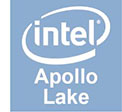 Apollo Lake uses an Atom-based x86 microarchitecture named Goldmont, as well as a graphics core with the same Gen9 architecture as is in Intel's 6th generation "Skylake" Core processors. Apollo Lake uses an Atom-based x86 microarchitecture named Goldmont, as well as a graphics core with the same Gen9 architecture as is in Intel's 6th generation "Skylake" Core processors.
The Celeron N3350 in the LYNX runs at a base frequency of 1.10GHz but can reach burst frequencies of up to 2.40GHz. It's a dual-core/dual-thread design with a thermal design power of six watts, significantly lower than the 15 watts of most current ultra-low voltage Intel Core processors used in tablets and notebooks. That means no fan is needed. We're not talking Intel Core processor performance, but plenty enough for most IoT gateway and similar applications.
To see how the dual-core N3350 fares in the Portwell LYNX 612G, we used Passmark Software's PerformanceTest 6.1 that runs about 30 tests covering CPU, 2D graphics, 3D graphics, memory, and disk and then computes scores for each category and an overall PassMark score. We also ran our secondary standard benchmark suit, CrystalMark. For comparison we added a couple of other IoT gateways we've tested in our lab:
|
IoT Gateways
|
Portwell
|
Advantech
|
Winmate
|
|
Model
|
LYNX-612G
|
ARK-1123
|
EACIL67
|
|
CPU
|
Celeron N3350
|
Celeron J1900
|
Celeron N3350
|
|
CPU Code Name
|
Apollo Lake
|
Bay Trail
|
Apollo Lake
|
|
CPU Cores/Threads
|
2/2
|
4/4
|
2/2
|
|
CPU TDP
|
6 watts
|
10 watts
|
6 watts
|
|
CPU Mark
|
1,197.3
|
2,203.4
|
1,282.9
|
|
2D Graphics Mark
|
96.5
|
181.4
|
267.4
|
|
Memory Mark
|
441.0
|
444.2
|
920.1
|
|
Disk Mark
|
1,375.2
|
594.6
|
1,783.5
|
|
3D Graphics Mark
|
182.6
|
138.1
|
272.7
|
|
Overall PassMark
|
713.1
|
787.2
|
901.1
|
|
CrystalMark ALU
|
17,040
|
26,844
|
19.942
|
|
CrystalMark FPU
|
12,859
|
22,649
|
16,676
|
|
CrystalMark MEM
|
19,560
|
19,657
|
21,046
|
|
CrystalMark HDD
|
33,908
|
9,048
|
33,513
|
|
CrystalMark GDI
|
5,185
|
5,593
|
6,014
|
|
CrystalMark D2D
|
1,866
|
3,959
|
2,050
|
|
CrystalMark OGL
|
3,557
|
3,511
|
4,292
|
|
Overall CrystalMark
|
93,984
|
91,261
|
103,533
|
Benchmark results, of course, are relative. While more is always better in consumer and enterprise desktops and laptops, that's not generally the case in industrial systems. Those have a "target" performance, just enough to get the job done. Space, cost, thermal considerations all come into play. The benchmark performance level of these three IoT gateways is roughly at the same level, only a fraction of a high-end modern laptop, but as fast or faster than any high-end mobile computer of a decade ago.
Perusing the numbers it's evident that storage technology has advanced as fast or faster than even processor technology, and Portwell took advantage of that.
Universal IoT Connector
The LYNX (and a good number of other Portwell embedded systems) support the Universal IoT Connector, or UIC. While this sounds like a physical plug standard, that's not what the UIC is. 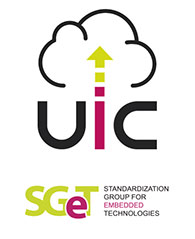 Instead, it is a framework for easily connecting embedded systems the cloud, no matter whose cloud technology it is. Instead, it is a framework for easily connecting embedded systems the cloud, no matter whose cloud technology it is.
The UIC standard consists of the hardware and its drivers, the application server, and then a configuration module or server.
Portwell, listed on the UIC website as an official member, was one of the initiators of the UIC standardization effort, and UIC is now part of many of Portwell's various IoT Gateway solutions.
Portwell LYNX: Significant application potential
With their LYNX line of ultra-compact industrial PCs, Portwell offers computing power and substantial connectivity small enough to fit just about anywhere. While nominally described as an IoT gateway product, the LYNX is suitable for all sorts of industrial automation, smart factory, edge computing and related applications.
Processing performance isn't scalable as it is in larger systems that usually offer a wide range of CPU options. If that's not an issue, then the LYNX can be the answer for all sorts of applications.
For IoT applications, there's Microsoft Azure and Universal IoT Connector support Portwell offers for the LYNX. That alone can make a huge difference. -- Conrad Blickenstorfer, August 2020
|

